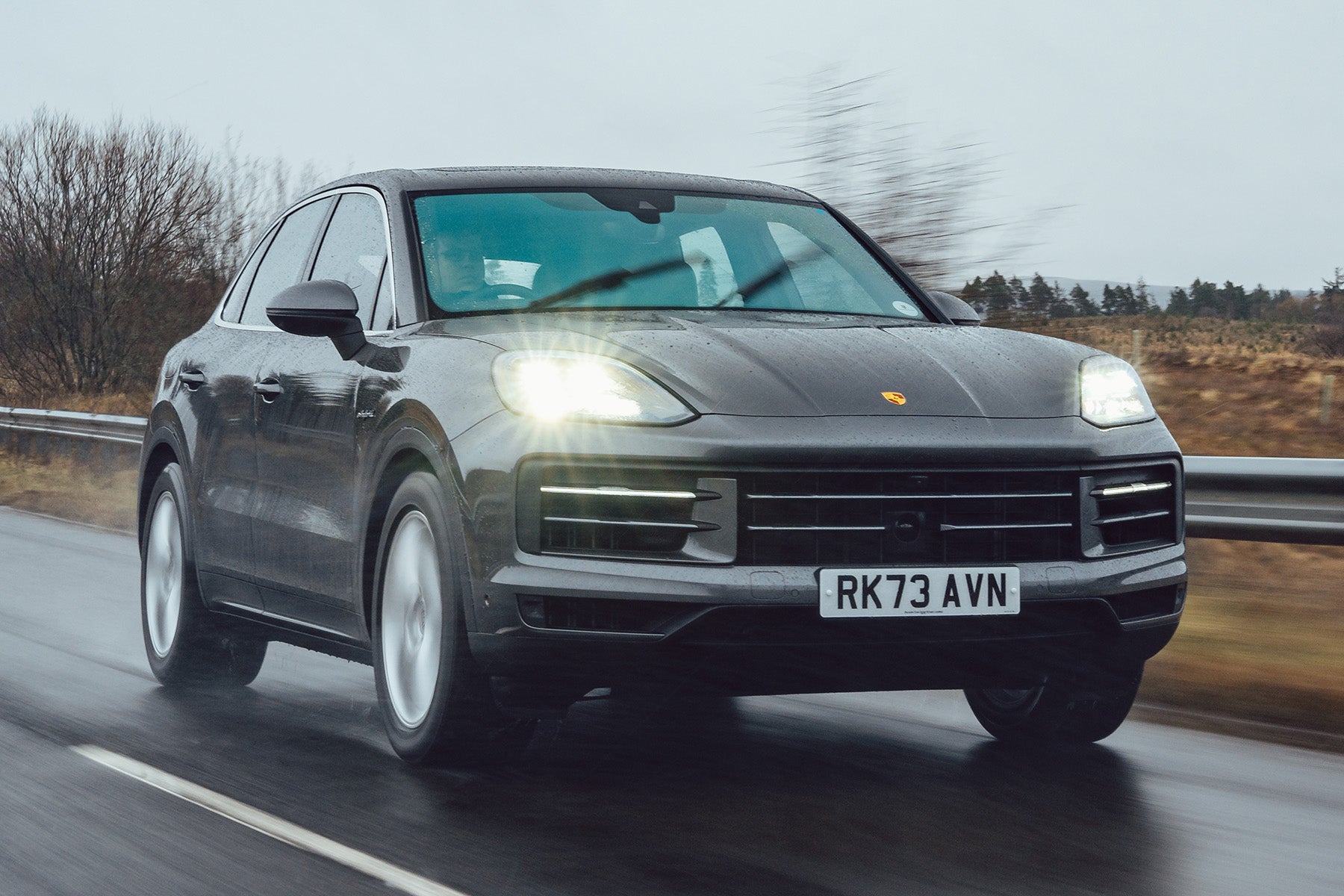Porsche Cayenne Review 2024
Written by Andy Brady
Quick overview
Pros
- Genuinely luxurious premium SUV
- Brilliant interior
- Outstanding performance – and electric drive ability of E-Hybrid
Cons
- Expensive to buy
- Not available with seven seats
- Even the Cayenne E-Hybrid will be expensive to run
Overall verdict on the Porsche Cayenne
"If you're looking for a practical, family SUV but don't want to compromise on style and performance, we reckon you'll struggle to beat the latest Porsche Cayenne. Revisions in 2024 are relatively minor but ensure it remains one of the most desirable SUVs on the market today. The only real catch is whether you can justify its high price tag."
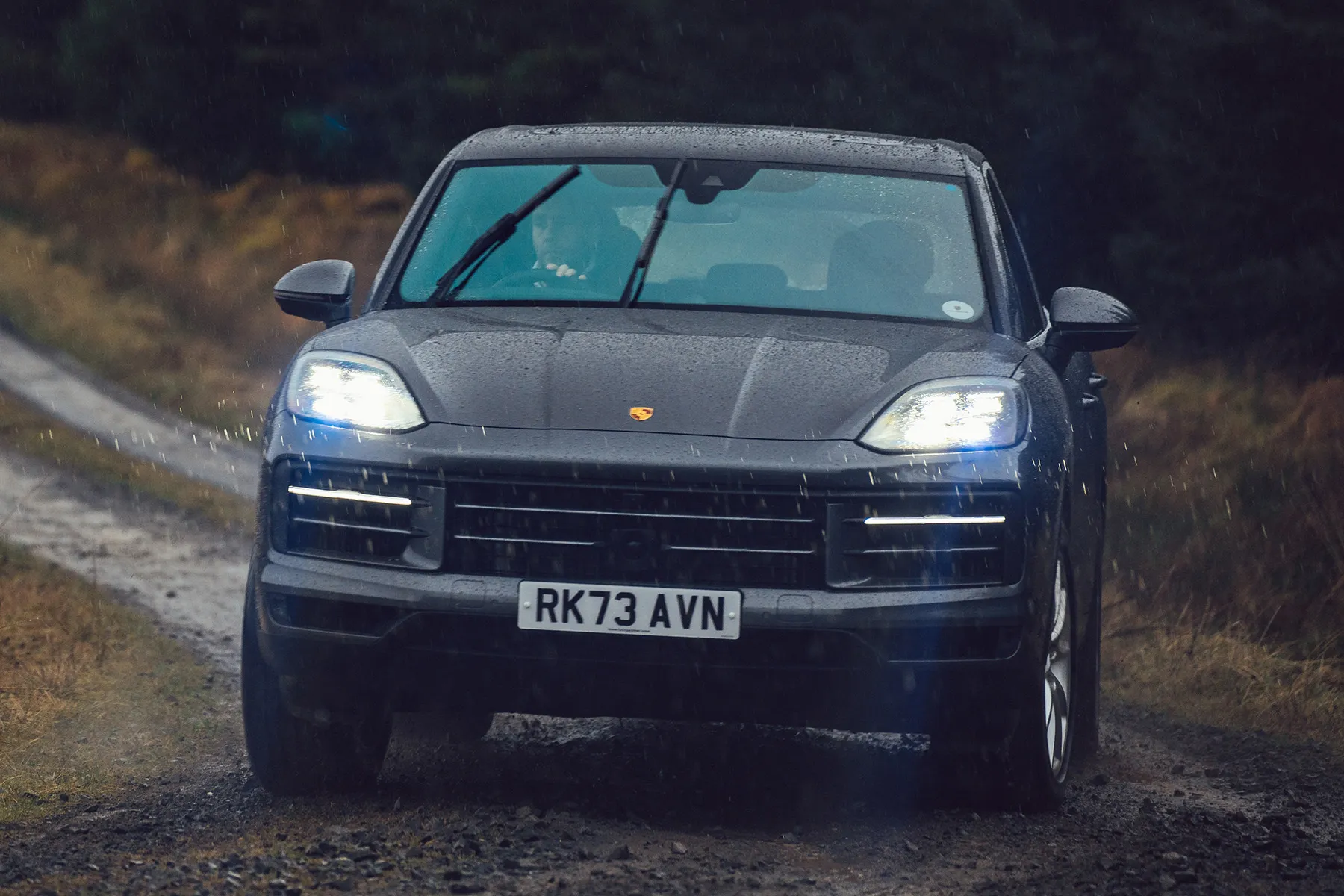
Porsche’s pioneering luxury performance SUV has enjoyed several decades of putting up the hackles of diehard sports car enthusiasts. ‘Porsche shouldn’t be making a large, heavy SUV,’ they exclaimed when it was launched. Yet today, the Porsche Cayenne outsells every Porsche sports car by a comfortable margin – and its smaller SUV sibling, the Macan, sells even more still.
The Porsche Cayenne has been a real success story that has made the company a fortune. And that allows Porsche to continue investing in the sports cars that enthusiasts only have eyes for. Because it’s such a profitable car, Porsche has continued to develop the Porsche Cayenne, too. This latest model, introduced in 2017 and revamped in 2024, is easily the most advanced and convincing version yet.
For starters, doesn’t it look good? Now we’re used to the idea of a mammoth Porsche SUV, we can appreciate how the German brand has refined the look of the Porsche Cayenne. It seems longer, more elegant and less bulky, while the broad, powerful front end is far more stylish than anything that’s gone before. No, it’s not a natural beauty, but no SUV is (except, maybe, the Range Rover Velar). This is, however, a sophisticated and modern-looking machine, with plenty of head-turning appeal.
The latest Porsche Cayenne is genuinely luxury-grade inside, too. Many of the advanced high-end luxury features first seen in the electric Porsche Taycan have been carried across, including its fascinating touchscreen displays and cutting-edge controls. It’s very high tech and will be an endless talking point for passengers.
When they’ve stopped gawping at the various screens and touch-sensitive controls, they may well notice what a comfortable machine it is, too. The seats are truly indulgent, with armchair-like qualities and plenty of space all around. Porsche hasn’t bothered to make the Porsche Cayenne into a seven-seater (that would certainly be a step too far for the diehards), but has instead optimised it for five people – or, better still, just four.
It’s a good job the interior is so refined and relaxing, given the amount of performance the driver has available. Even a standard V6 petrol will easily alarm people on board with its speed, and the Porsche Cayenne Turbo S E-Hybrid is truly boundary-pushing, with 739PS summoning up 0-62mph in just 3.7 seconds. It also has an extra eco trick up its sleeve thanks to plug-in hybrid technology.
There are a few things missing from the Porsche Cayenne range, although they won't necessarily concern a lot of buyers. You can't get a diesel model (Porsche has ruled out ever making a diesel again), and you can't get the Porsche Cayenne with seven seats. If you want a Cayenne with a bit more style, you can, however, get a Porsche Cayenne Coupe.
Since being launched in 2017, the latest Porsche Cayenne has sold well. There’s a very rich mix of manufacturer-approved used examples out there, offering an entry into latest-generation Porsche luxury for a fair bit less than you’ll pay new. Read on to find out why the Porsche Cayenne deserves your enthusiasm.
heycar has 1000s of used cars for sale, including a wide range of Porsche Cayennes for sale.
Is the Porsche Cayenne right for you?
With a (very) premium price tag and an extensive options list, you need deep pockets to consider a Porsche Cayenne. It holds its value exceptionally well, too, so you'll pay a premium for one on the used market.
If you can justify it, though, the Porsche Cayenne is probably the ultimate large SUV. It's a true luxury-grade machine, which can go head-to-head with alternatives such as the Range Rover Sport. It looks more upmarket than ever before, so if you want to show the world you’ve arrived, it may well be for you.
What’s the best Porsche Cayenne model/engine to choose?
While the base Porsche Cayenne is itself fast, the extra attitude of the Porsche Cayenne S somehow seems more convincing. It’s surprisingly easy to justify the extra expenditure. Same goes for the E-Hybrid, which isn’t hugely more than the base car, but is both more technically interesting and socially acceptable. The range-topping Porsche Cayenne Turbo S E-Hybrid is the most ludicrous, with colossal power, a wild £130k price tag, yet also some semblance of eco-consciousness - it really is quite a beast.
What other cars are similar to the Porsche Cayenne?
The Porsche Cayenne is built on the same architecture as the Audi Q7 and Volkswagen Touareg. It’s also related to the Bentley Bentayga and Lamborghini Urus. How about that for good breeding?
Rivals include the Range Rover Sport, which owners seem to have no qualms about spending a small fortune on. There’s also the luxurious BMW X5, spacious Mercedes-Benz GLE (including the high-performance Mercedes-AMG versions) and the Jaguar F-Pace, while the Tesla Model X is an intriguing all-electric alternative to the plug-in hybrid Porsche Cayenne. The Jaguar I-Pace is another electric sports SUV rival, too, as well as the Audi Q8 e-tron.
Comfort and design: Porsche Cayenne interior
"The Porsche Cayenne's cabin was tweaked in 2024 with a subtle nudge towards a cleaner, more minimalist layout. The gear shifter has been moved to the dashboard, while everything that the driver uses regularly is now located on (or close to) the steering wheel."
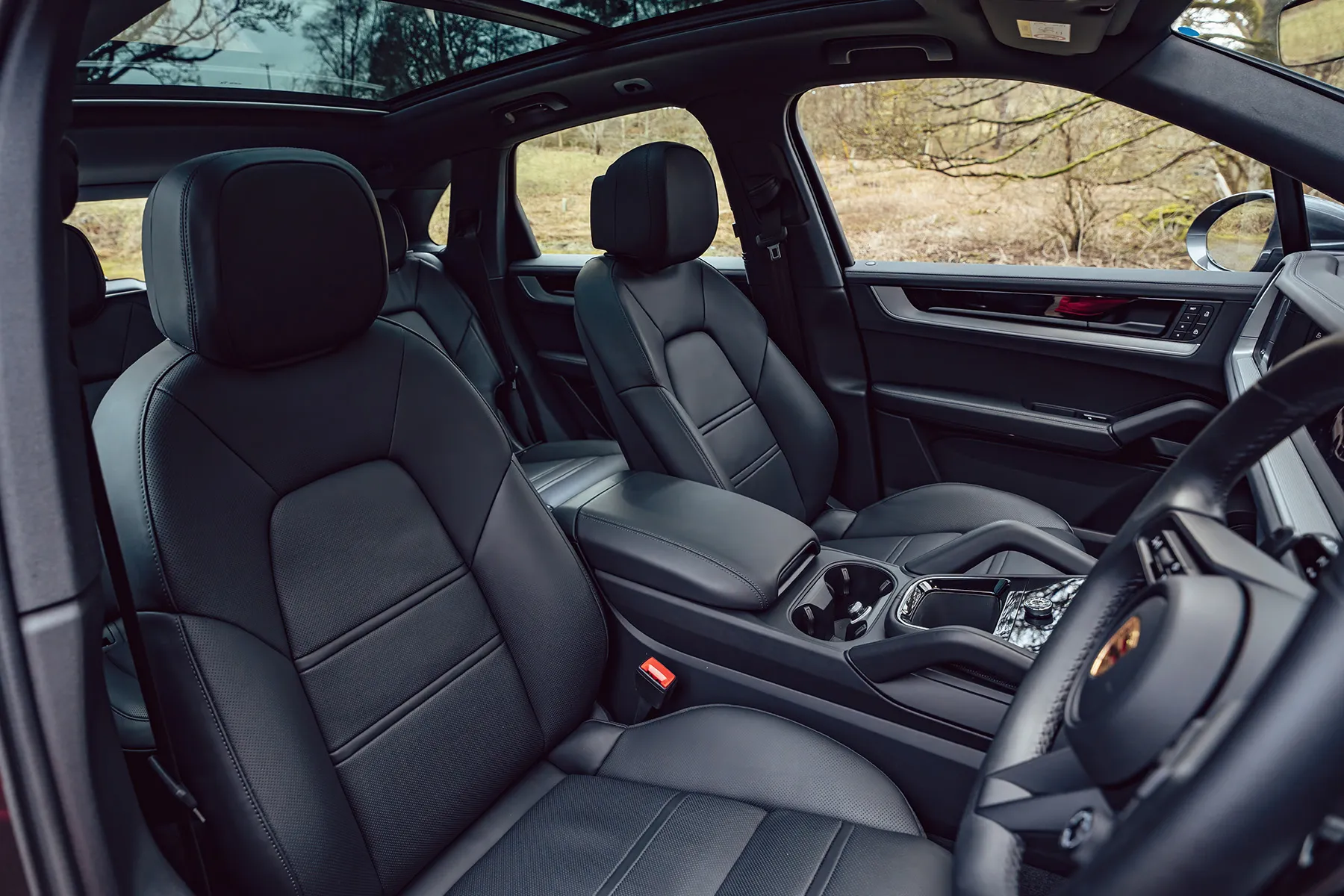
The revisions are relatively minor but do mean the Cayenne's interior feels thoroughly up-to-date - it's not that dissimilar to the electric Porsche Taycan inside, or even the brand new Macan EV. Porsche says it's keen to find "the right balance between digital and analogue elements," which explains why there are switches for the climate control and an old-fashioned volume control dial. It's much more user-friendly than lumping everything into the touchscreen display.
There's no shortage of digital displays inside the Cayenne, though. All models come with a beautifully slick central screen which is a joy to use, with endless configurability options. You can now get another display for the passenger side, too, which really adds to the high-tech vibe.
The seats are wonderful. They feel sporting, in an authentically Porsche way, but they’re also comfortable and supple enough for long-distance motoring. You wonder why all luxury car seats can’t be like this – they have just the right level of support without feeling like you’re sitting on a park bench. As you move up the range, the seats become even more indulgent – we particularly like the optional adaptive sports seats fitted to our test car.
We must also mention the steering wheel, which feels just like that in a 911. It may seem incongruous to grab a sports car steering wheel in a luxury SUV, but it’s actually a lovely design detail that feels special each time you climb behind it. It even has the same suspension controller dial (if the optional Sport Chrono pack is specified) as a 911, for added authenticity.
Quality and finish
Quality is impeccable. While the first generation Porsche Cayenne may have let the side down in a few key areas, the company is absolutely back to its very best with this latest 2017-on model.
Everything is fantastic to the touch. Most of the interior is lined in leather, and the parts that aren’t either use the richest, softest-touch plastics, or are clad with impeccably well-finished trim panels. It’s less like a car and more like a luxury hotel.
Even the switchgear is gorgeous, with tiny silver controls clicking beautifully and feeling almost jewel-like. Yet it’s the clarity of the displays that dominate the interior which really give the Porsche Cayenne a modern, high-end look. It’s all so crisp and cool, and incredibly classy. All the luxury that’s built into the latest Porsche Panamera is in evidence here – and how.
Infotainment: Touchscreen, USB, nav and stereo in the Porsche Cayenne
The 12.3-inch touchscreen is a joy to use. It’s like you’re operating a really expensive tablet, so responsive and tactile does it feel. There’s not a hint of lag or delay, and the system responds swiftly to even the lightest finger-touch. This latest-generation Porsche Communication Management is fitted with Porsche Connect Plus for online services and navigation. It’s fully personalisable and up to six profiles can be configured, ready to use at the press of a button.
Functions that aren’t controlled through the touchscreen itself are operated via a smartphone-like glass touch surface, which gives acoustic and haptic clicks in response to a finger jab. It’s all very space-age and sophisticated. Needless to say, a 4G modem, wi-fi hotspot and full Porsche Connect services are fitted as standard.
Buy a 2024 Porsche Cayenne and you'll also get a 12.6-inch digital instrument cluster with a curved floating design. This looks pretty slick, leaving little need for the optional head-up display. If that's not enough, you can also get a 10.9-inch display on the passenger side. This is an impressive (if slightly gimmicky) feature - especially as a special filter prevents the driver from being distracted by the additional screen.
Space and practicality: Porsche Cayenne boot space
The latest Porsche Cayenne is a seriously imposing car: over 4.9 metres long and almost two metres wide (and that’s with the door mirrors folded in). It’s also nearly 1.7 metres tall and, yes, it’s heavy – weighing two tonnes even in base-spec guise (the E-Hybrid is over 2.3 tonnes).
It’s therefore fittingly spacious on the inside. In the front, it feels palatial. You step up high into it, climbing into a wide cabin with a huge centre console that seems to position you far away from your fellow front-seat passenger. With your right arm on the wide windowsill and left elbow on the adjustable armrest, you’ll feel like the king of the road.
It’s vast in the rear, too. This is a no-compromise machine, with a rear seat that isn’t compromised by the need to get a third row of passengers into the rear. It’s very roomy, with plenty of width for three adults, loads of headroom, leg-crossing kneeroom and enough foot space to stretch back and relax.
The middle-seat passenger might not quite feel as comfortable as the outer two, but that’s only because the other seats are so comfortable and nicely shaped. With big windows to stare out of and a plethora of air vents to control the rear-seat climate, it’s a real haven back there.
The boot is, you won’t be surprised to hear, mammoth. At its largest, seats-up space stretches to 770 litres – that’s truly enormous, and around 100 litres bigger than even its predecessor. Folding the seats down extends the space to 1,710 litres, which is on a par with the very largest estate cars. The Panamera is a hugely practical and spacious machine and easily justifies itself for the flexibility it delivers. Just note that if you do pick the E-Hybrid version, boot space will shrink by 100 litres, due to the batteries in the back.
As for child seats, there are ISOFIX mountings on the outer two rear seats, but Porsche chose not to utilise the Cayenne’s extra width to fit a third ISOFIX seat mount. There isn’t an ISOFIX mount on the front passenger seat either, although you will find an airbag cut-off switch.
The Porsche Cayenne dimensions are 4918mm long, 2194mm wide and 1696mm tall.
Handling and ride quality: What is the Porsche Cayenne like to drive?
"Right from the very first Porsche Cayenne, Porsche’s luxury SUV wowed the world with just how genuinely sporting and satisfying it is to drive. It shouldn’t be possible for such a large and heavy machine to handle in quite such a satisfying way, but that’s without factoring in the unique Porsche magic. It’s even possible to get the Porsche Cayenne drifting around a racetrack if you really want to (we did). That’s how unexpectedly lithe and agile it can be."
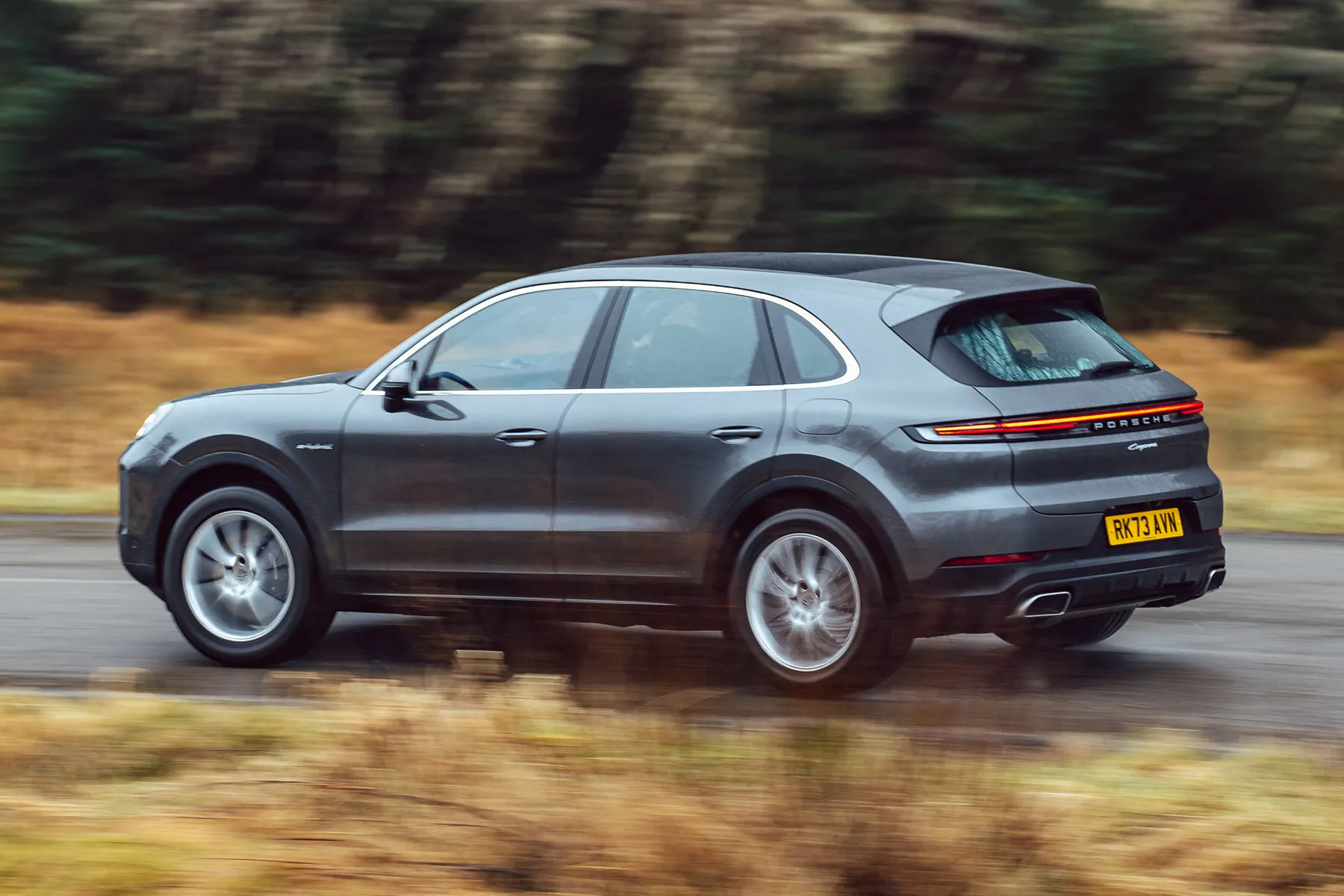
Steering feel is particularly good, with a really tight, sharp setup. It’s flickable and further enhanced by how well-positioned the steering wheel is – it sits in your lap and feels completely intuitive. Once again, more like a 911 than an SUV.
The Porsche Cayenne has a plethora of suspension options, masterminded by 4D Chassis Control networking. Porsche Cayenne S models get adaptive PASM dampers, while adaptive air suspension with three-chamber technology enhances both the sportiness and the luxury car ride. Buyers can also choose electric rear axle steering, Porsche Dynamic Chassis Control with active anti-roll, and even tungsten carbide-coated disc brakes. That’s if you can’t quite justify spending thousands on the PCCB ceramic brakes.
Porsche hasn’t made a glorified rally car, though. The ride is as plush and luxurious as you’d expect, with fine isolation in standard mode. And it only improves as you move up through the various suspension options. For the best ride, stick with the smaller alloys, but things don’t degenerate significantly even with 21-inch rims.
There’s an extra sports car-related factoid that owners might also like to throw into conversation. For the first time, the Porsche Cayenne has mixed tyres: wider at the rear than the front. Name another car with mixed tyres? Yep, the Porsche 911.
What engines and gearboxes are available in the Porsche Cayenne?
Even the ‘slowest’ Porsche Cayenne now has 353PS from its 3.0-litre V6 turbo engine, which is good for 154mph all-out and 0-62mph in 6.0 seconds flat. On pre-facelift models, the Cayenne S used a 2.9-litre V6 turbo engine - but it's now been given a 4.0-litre V8 that produces 474PS. That's good news as not only is it quicker (0-62mph acceleration takes 5.0 seconds), it also sounds incredible - much bassier than the old V6.
If you're looking for a Cayenne that's even moderately efficient, the Porsche Cayenne E-Hybrid is one of the best hybrid SUVs on sale. The standard E-Hybrid pairs a 3.0-litre V6 petrol engine with an electric motor to produce a combined 470PS - taking it to 62mph in 4.9 seconds. The Cayenne S E-Hybrid boosts this to 519PS, dropping the 0-62mph time drops to 4.7 seconds.
For the ultimate fast SUV, the range-topping Porsche Cayenne Turbo E-Hybrid combines the 4.0-litre V8 engine with an electric motor to produce 739PS and a whopping 950Nm of torque. 0-62mph acceleration takes just 3.7 seconds while top speed is 183mph. And it does all this while having the capacity to run for 45 miles as a silent, zero-emissions EV. Incredible.
All Porsche Cayennes use an automatic gearbox: the fast and smooth-shifting eight-speed Tiptronic S transmission.
Refinement and noise levels
The Porsche Cayenne is a beautifully refined machine, with its enormous structure being packed with insulation and the most intricate measures to eradicate noise. Remember, the base platform is also used by the luxurious Bentley Bentayga, so refinement will have been prioritised from the outset.
Despite the steamroller wheels, tyre noise isn’t too intrusive, and double glazing will keep wind noise at bay. The ability of E-Hybrid models to operate as silent-running EVs further enhances this incredible refinement. If you don’t want the Porsche Cayenne quite so silent, look for one with the optional sports exhaust system.
The calm, serene interior is the perfect place to enjoy some high-end audio, with Porsche offering systems from Bose and Burmeister, depending on your budget and how ‘concert hall’ you want things.
Safety equipment: How safe is the Porsche Cayenne?
It’s not often that expensive, luxurious cars such as the Porsche Cayenne are crash-tested by Euro NCAP. The honour was carried out in 2017, though, where it perhaps unsurprisingly scored five stars (imagine the shock if it hadn’t). Adult occupant protection is outstanding, at 95%, and child occupant protection was rated at 80%. The Porsche Cayenne also scored 73% for pedestrian safety and 62% for safety assist systems.
An active pop-up bonnet helps pedestrian safety by reducing the risk of heads coming into contact with anything hard in the engine bay. Porsche also fits autonomous emergency braking that detects pedestrians and other obstacles such as cyclists at city-centre speeds, while the cruise control has a speed limiter built in. Surprisingly, though, a lane-keep assist system is only optional.
There’s a full suite of airbags, including knee airbags for both front occupants – but again, it’s odd that side chest airbags are left on the options list for rear passengers.
Optional safety tech includes adaptive cruise control, the aforementioned night vision display, a lane-change camera, traffic sign recognition and a 360-degree parking camera.
MPG and fuel costs: What does a Porsche Cayenne cost to run?
"Without the option of a diesel engine, buyers seeking low running costs will need to look for a plug-in hybrid - and make sure you charge it regularly if you don't want to spend a fortune on fuel."
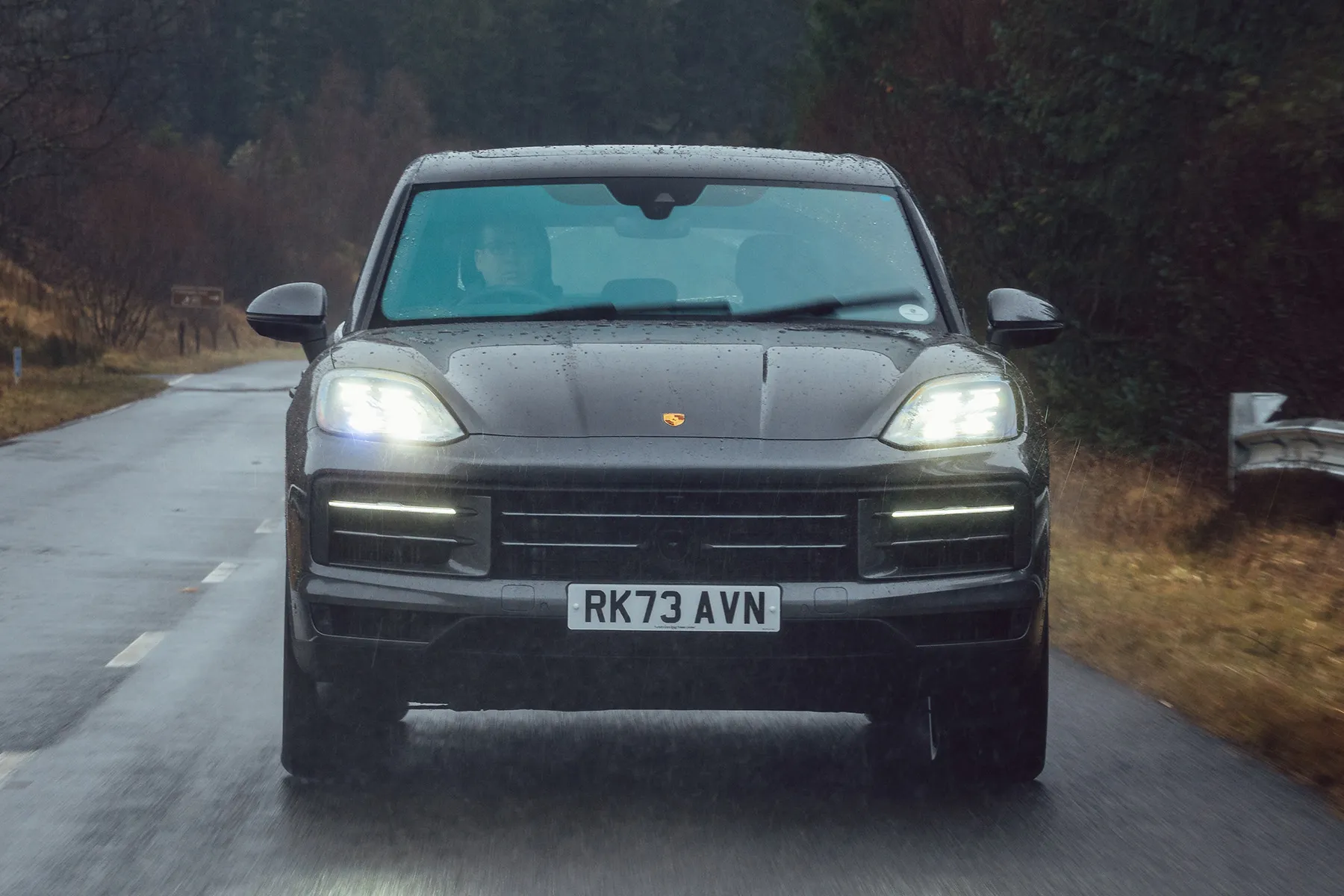
The two plug-in hybrids look extra efficient on paper, due to how the tests are conducted. Officially, the Cayenne E-Hybrid manages up to 201.8mpg, while the Turbo E-Hybrid sees up to 166.2mpg. These incredible figures will only be possible if you plug the car in and rarely venture beyond its electric-only range - in which case, you might be better looking at a pure-electric alternative like the Audi Q8 e-tron instead.
Still, with an official electric range of up to 56 miles, a plug-in hybrid Cayenne makes a lot of sense for those wanting an eco runaround during the week, with the ability to cover continents at the weekend. When the battery's flat, expect similar fuel economy to a regular Cayenne.
A standard Porsche Cayenne returns up to 26.2mpg in official tests, while the Cayenne S manages 22.8mpg.
How reliable is a Porsche Cayenne?
You might think a secondhand Porsche is a brave purchase, but the manufacturer actually ranked fourth in a recent ownership survey by consumer advice website HonestJohn.co.uk. The Cayenne comes with a three-year, unlimited mileage warranty. There's no need to worry about the complex Cayenne E-Hybrid, either, as its hybrid system is covered for eight years/100,000 miles.
Insurance groups and costs
It goes without saying that the Porsche Cayenne is going to be a costly machine to insure. Not only is it a desirable SUV, it’s one wearing a sports car badge on the nose. Saying that, not every model drops into the highest insurance group 50. The standard Porsche Cayenne, which seems a good blend of performance and relative affordability, is group 44. Things quickly rise, though – the Cayenne S is group 48 and even the standard E-Hybrid is group 50.
VED car tax: What is the annual road tax on a Porsche Cayenne?
Like all premium SUVs, you're going to be stung by road tax in the new Porsche Cayenne. While first-year rates are based on emissions (and lumped into the on-the-road price), you'll pay a standard rate of £180/year to tax the Cayenne... or £170/year for E-Hybrid models. On top of that, all Cayennes will be hit by an extra £390/year in 'premium car tax' for five years (from the second time the car's taxed). The only way to avoid this is by looking for an SUV with a list price of less than £40,000, or by buying a pure-electric alternative such as the Audi Q8 e-tron.
How much should you be paying for a used Porsche Cayenne?
"The Porsche Cayenne was given a substantial update in 2024. You'll have to pay top money for one of these - a brand new Cayenne starts from around £70,000, while the range tops out with the £130,000 Cayenne Turbo E-Hybrid. And that's before you start browsing the extensive options list..."
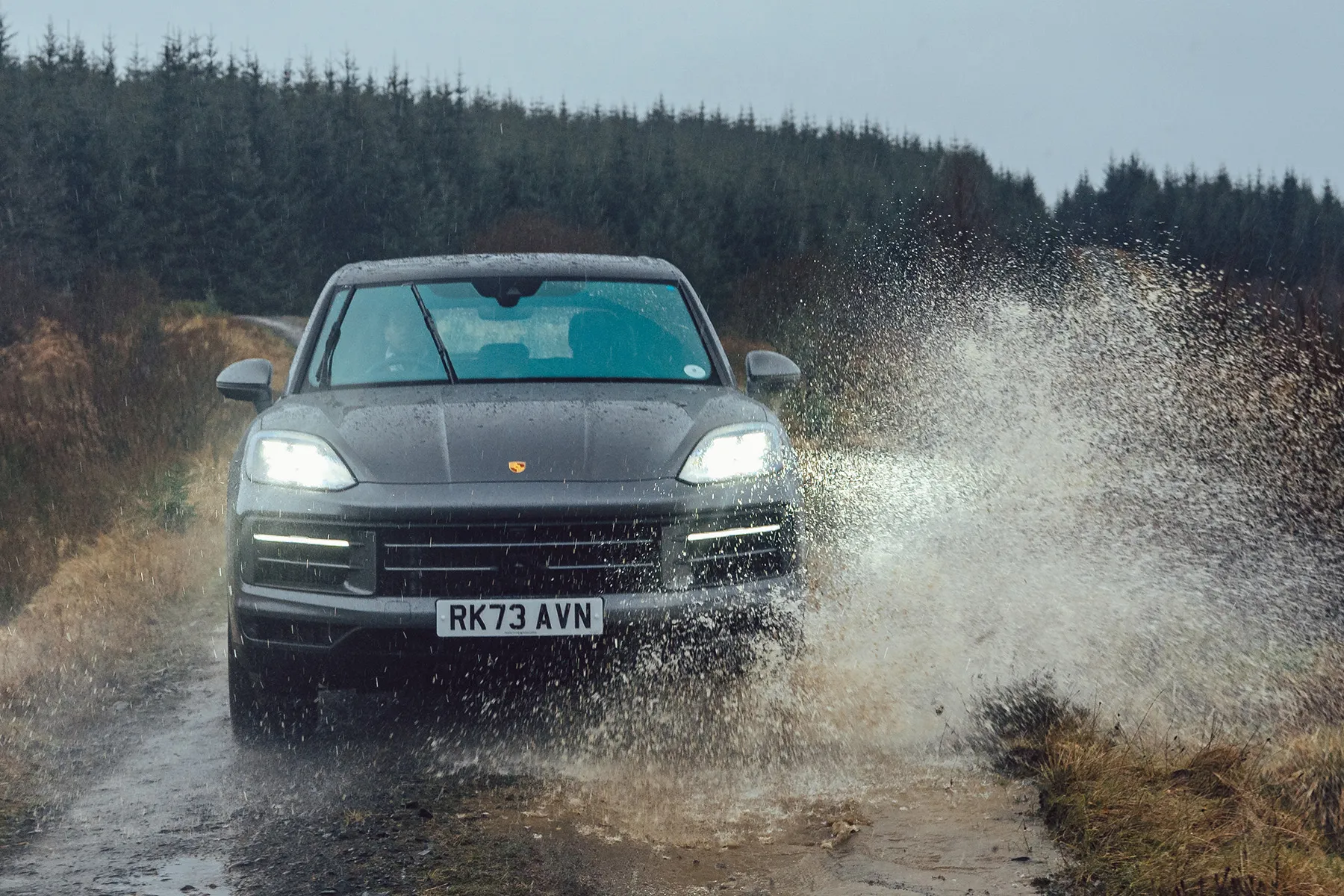
Like most Porsches, a new Cayenne will hold its value surprisingly well. That's good news if you're buying a new one, but there's no such thing as a bargain Cayenne on the used market. You can still save money by searching for a used Porsche Cayenne, though, especially if you're not fussed about having the latest 2024 model.
A budget of around £40,000 will pick up a used Porsche Cayenne from 2019, while £50,000 opens a greater breadth of options - including petrol, diesel and plug-in hybrid models. A used Porsche Cayenne Turbo can be picked up from around £60,000, while the Turbo S E-Hybrid is closer to £80,000.
Trim levels and standard equipment
As a luxury car, the Porsche Cayenne has all the essentials you’d expect. Standard equipment on the entry-level model includes 20-inch alloy wheels, heated front seats with electric adjustment, Matrix LED headlights, a 12.3-inch infotainment screen with Apple CarPlay and Android Auto, as well as a wide array of driver-assistance tech.
You don't necessarily get a great deal more standard equipment on more expensive models. You're essentially paying for punchier performance. Most Porsche buyers go to town on options - a vast array of optional extras is available - including multiple types of suspension, interior trim, premium audio, wheels, paint colours... you name it. This is what makes buying a new Porsche Cayenne so involved, and what makes searching for a used one so exciting.
Ask the heycar experts: common questions
What is the fastest Porsche Cayenne?
Is the Porsche Cayenne a reliable car?
Is the Porsche Cayenne a hybrid?
Get our latest advice, news and offers
Keep me updated by email with the latest advice, news and offers from heycar.
By submitting you agree to our privacy policy
